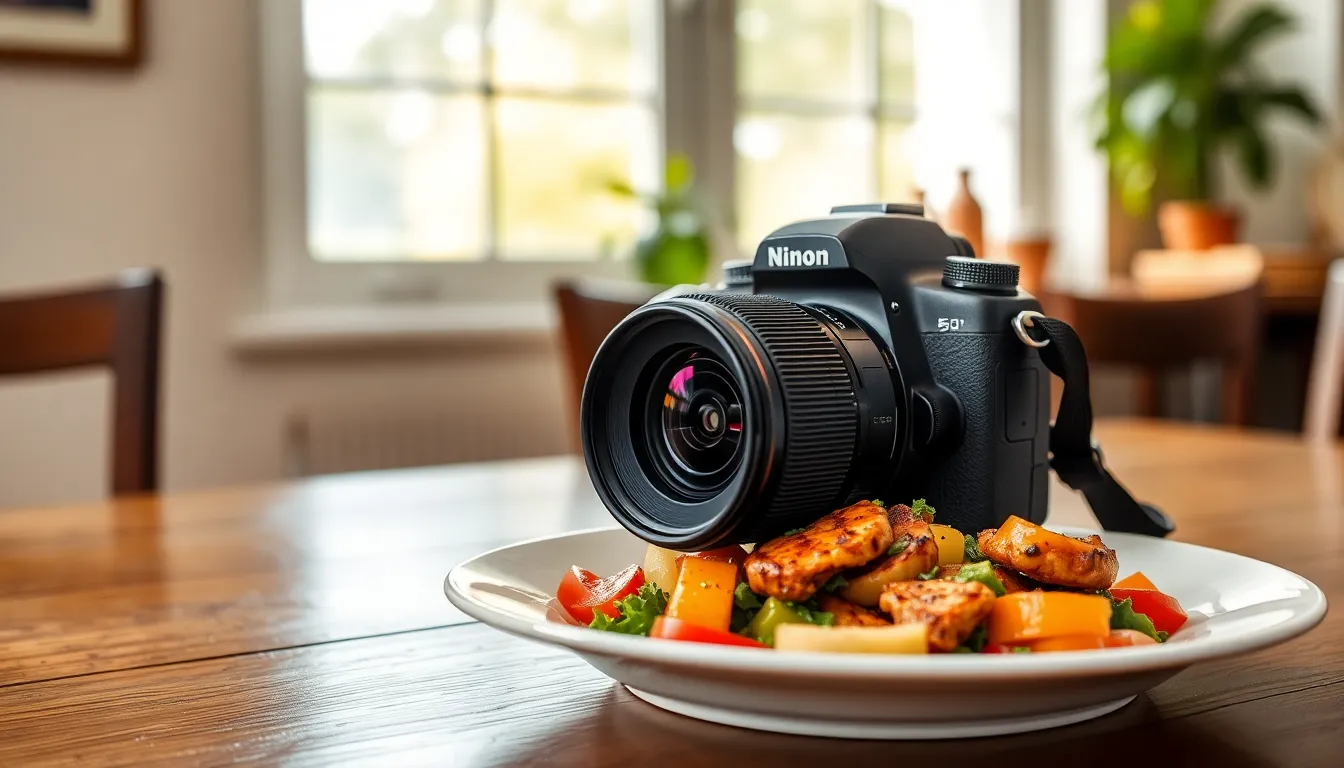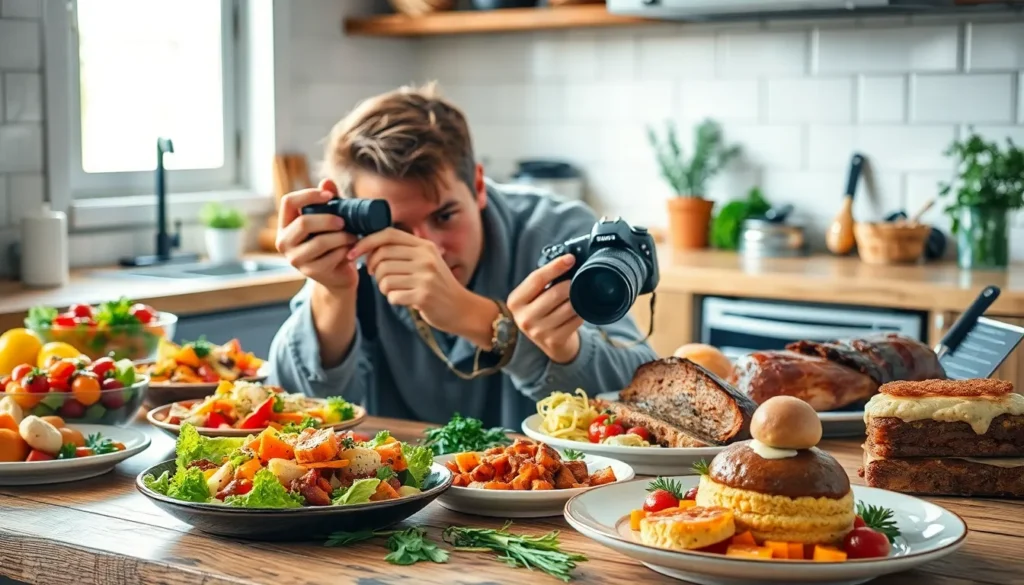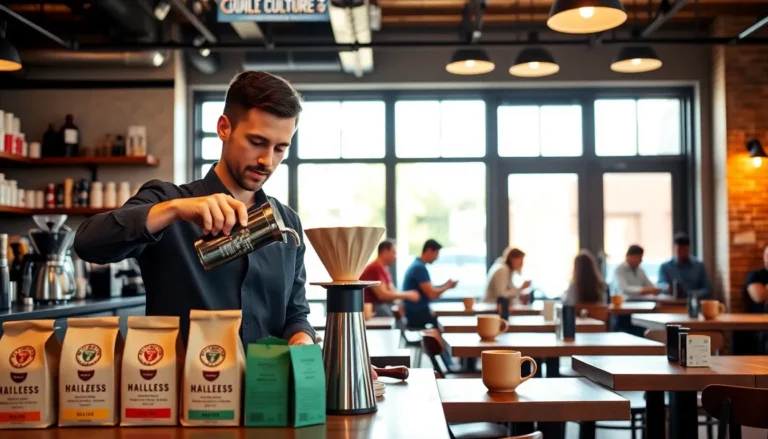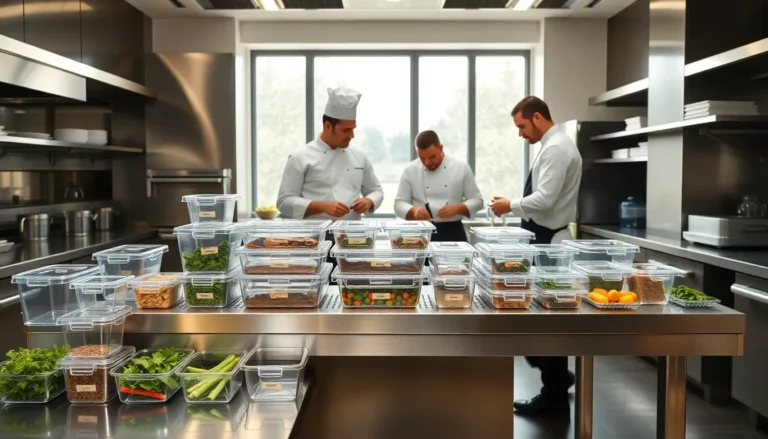In a world where social media reigns supreme, food photography has become an essential skill for both amateur cooks and professional chefs alike. Capturing the perfect shot of a delicious dish can elevate a simple meal into a visual feast, enticing viewers and making their mouths water. Whether it’s for a blog, Instagram, or a restaurant menu, the right techniques can transform ordinary food into stunning imagery.
Mastering food photography isn’t just about having the latest camera gear; it’s about understanding light, composition, and styling. With a few simple tips, anyone can create mouthwatering images that not only showcase culinary creations but also tell a story. From choosing the right background to experimenting with angles, these insights will help elevate food photography to new heights, making every dish look as delectable as it tastes.
Table of Contents
ToggleUnderstanding Food Photography
Food photography captures the essence of culinary creations, influencing how meals are perceived online. Successful images can elevate dishes, inviting audiences to engage with content.
Importance of Visual Appeal
Visual appeal plays a vital role in food photography. Engaging images attract attention on platforms like Instagram, sparking interest and encouraging sharing. Research indicates that posts with high-quality visuals generate 94% more views than those without. Appealing photos create a connection with viewers, enhancing their desire to try recipes or dine at restaurants.
Basics of Composition
Composition forms the backbone of effective food photography. Key components include:
- Rule of Thirds: Dividing the frame into three equal parts, one can place the subject along these lines for a balanced look.
- Leading Lines: Utilizing lines (like table edges) can guide the viewer’s eye toward the dish.
- Framing: Surrounding the subject with elements in the scene can draw attention and create depth.
- Negative Space: Incorporating empty space around the subject can make it stand out and enhance focus.
These composition techniques foster visually compelling photographs, presenting food in an enticing manner.
Essential Equipment for Food Photography

Food photography requires specific tools to capture appetizing images effectively. The right equipment enhances clarity, light, and composition, resulting in striking photos that entice viewers.
Cameras and Lenses
Cameras significantly impact food photography quality. DSLR and mirrorless cameras provide versatility and control. These models support interchangeable lenses, enabling photographers to choose based on their creative vision.
Prime lenses, particularly those in the 35mm to 100mm range, excel at capturing food details with sharpness. Macro lenses allow close-up shots, highlighting textures and ingredients. In contrast, wide-angle lenses facilitate inclusive images, incorporating surrounding elements and backdrops effectively.
Lighting Tools
Lighting tools play a crucial role in food photography. Natural light serves as the first choice. It creates soft, flattering effects on food, enhancing colors and textures. Shooting near windows during daylight provides ideal conditions.
When natural light isn’t an option, artificial lighting can supplement or replace it. Softboxes create diffused lighting, eliminating harsh shadows. Reflectors bounce light onto the subject, enhancing highlights and reducing darkness.
LED lights offer flexibility; some models allow color temperature adjustments. Light diffusers soften direct light, providing a more appealing look to the dishes. These equipment combinations foster the desired ambiance, making food visually appetizing.
Techniques for Stunning Food Photos
Effective food photography relies heavily on understanding light, composition, and angles. Mastering these techniques results in striking images that captivate viewers.
Natural Light vs. Artificial Light
Natural light creates soft, flattering illumination for food photography. It enhances colors and highlights textures without harsh shadows. Early morning or late afternoon light serves as the best option, offering a warm glow. Photographers can position food near windows to utilize this light effectively.
Artificial light, while adjustable, may require a more careful approach. Softboxes and LED lights provide consistent brightness and enable control over shadows. Using diffusers helps soften the light, creating a natural look. Combining both natural and artificial light can yield impressive results, allowing photographers to balance brightness and shadow.
Angles and Perspectives
Experimenting with different angles can significantly alter a photograph’s impact. Overhead shots, or bird’s-eye views, provide a comprehensive look at plate layouts and intricate designs. This perspective works well for flat dishes, such as salads or spreads.
Three-quarter angles showcase depth, especially for layered dishes like cakes or burgers. This perspective allows viewers to appreciate the dish’s height and texture.
Close-up shots capture details and textures, emphasizing freshness or intricate plating. Utilizing leading lines narrows viewer focus, drawing attention to specific food elements. Photographers should consistently explore various angles to discover the one that best communicates the dish’s appeal.
Styling and Presentation Tips
Effective styling and presentation significantly enhance food photography. Strategic choices can transform a simple dish into a captivating image.
Selecting Props and Backgrounds
Choosing props and backgrounds plays a crucial role in food photography. Consider these factors for impactful styling:
- Color Harmony: Select props and backgrounds that complement the food’s colors. Neutral tones often enhance vibrant dishes, while contrasting colors can create striking visuals.
- Texture Variety: Incorporate different textures, such as wooden boards, cloth napkins, or ceramic dishes. These elements add depth and interest to the composition.
- Minimalism: Use props sparingly to avoid clutter. A few well-chosen elements often focus attention on the food without overwhelming the viewer.
- Seasonal Themes: Integrate seasonal props to align with holidays or festivities, enhancing the overall appeal. For example, autumn leaves for fall dishes or fresh flowers in spring settings can enhance a scene significantly.
Plating Techniques for Various Dishes
Plating influences how food appears in photos. These techniques enhance visual appeal:
- Height Variation: Create height with layered dishes or stacking elements. This adds dimension and draws the viewer’s eye.
- Sauce Art: Use sauces creatively, either drizzled on the plate or applied as decorative splashes. This adds visual flair and highlights the dish’s flavors.
- Symmetry and Balance: Arrange elements symmetrically for classic dishes or asymmetrically for modern looks. Achieving a balanced composition keeps the viewer engaged.
- Fresh Garnishes: Incorporate fresh herbs or edible flowers as garnishes. These enhance colors and provide context, making the dish feel fresh and appetizing.
Implementing these styling and presentation tips improves food photography, enhancing creativity and inviting viewers to indulge visually.
Editing Your Food Photos
Editing enhances the allure of food photography, refining images to highlight textures and colors. Utilizing the right software and techniques can elevate photo quality, making dishes more enticing.
Software Options
Popular editing software enhances food photography. Programs such as Adobe Lightroom and Adobe Photoshop offer robust features for adjusting exposure, contrast, and color balance. Additionally, mobile apps like Snapseed and VSCO provide accessible editing options for on-the-go adjustments. These tools allow photographers to refine images professionally, regardless of the platform used.
Basic Editing Techniques
Effective editing techniques improve overall image quality.
- Adjust Brightness: Increase brightness to enhance visibility and attract attention.
- Enhance Contrast: Boost contrast to create depth, making colors more vibrant.
- Crop Strategically: Crop to eliminate distractions, focusing on the dish.
- Saturation Adjustment: Increase saturation for richer colors; avoid overdoing it to maintain realism.
- Sharpen Details: Apply sharpening selectively to emphasize textures, like crispy edges or glossy sauces.
- White Balance Correction: Adjust white balance to eliminate color casts and achieve true-to-life hues.
Implementing these basic editing techniques can transform food photos, making them visually captivating.
Mastering food photography is an exciting journey that blends creativity with technical skill. By understanding light composition and styling techniques photographers can elevate their images and make dishes irresistible. Experimenting with angles and backgrounds allows for unique perspectives that capture attention and spark interest.
The right equipment and editing tools play a vital role in achieving stunning results. With practice and a keen eye for detail anyone can create mouthwatering visuals that resonate with viewers. Embracing these tips will not only enhance food photography skills but also transform the way meals are presented and appreciated.



